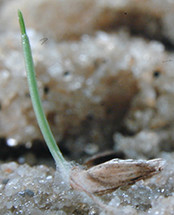Temperature and germination: the latest research from DLF
Recent research from DLF shows how different grass species and seed varieties germinate and establish when soil temperatures are low. There could be a seed mixture out there to help you defeat that unexpected cold snap.
22/02/2016
Low-temperature establishment of grass and clover
 No matter how good your soil is, seeds will not germinate till the temperatures are right. Grasses do tolerate a limited range of germination temperatures, but anything more extreme – soil temperatures that are too low or too high – and seeds remain dormant. Grass species vary, of course. Each has its own minimum and maximum germination temperatures. And within a species, minima and maxima also vary among varieties.
No matter how good your soil is, seeds will not germinate till the temperatures are right. Grasses do tolerate a limited range of germination temperatures, but anything more extreme – soil temperatures that are too low or too high – and seeds remain dormant. Grass species vary, of course. Each has its own minimum and maximum germination temperatures. And within a species, minima and maxima also vary among varieties.
In temperate zones, low soil temperatures often occur during early spring and late autumn. Wet soil makes the situation worse because it slows the process of soil heating.
All climate zones can experience high summer soil temperatures. The highest temperatures occur in dry, dark soils that absorb energy from sunshine.
DLF screening reveals large variations
Our researchers have screened numerous species and varieties for evidence of germination and subsequent growth across a range of low and high temperatures. We ran these tests because farmers need the most resilient seeds they can get. Growers gain a huge advantage if their grass seed germinates, for example, at temperatures as low as 4°C.
Seedling growth rates are also vital, especially at slightly higher temperatures of, say, 5° to 10oC. During winter sunshine, the soil surface can often achieve these higher temperatures.
Table 1 shows how different species perform at low temperatures. Ryegrass establishes fast; cocksfoot, timothy and fescues respond more slowly. In legume species the differences are smaller than in grass species.
Speed of establishment by species(expressed as a percentage of the average of the whole trial) |
|
|---|---|
| Species | Relative speed of establishment >100 = above average <100 = below average |
| Cocksfoot | 60 |
| Timothy | 70 |
| Tall fescue | 38 |
| Festulolium, type tall fescue | 58 |
| Meadow fescue | 27 |
| Festulolium, type ryegrass | 145 |
| Perennial ryegrass | 96 |
| Hybrid ryegrass | 127 |
| Italian ryegrass | 148 |
| Westerwold ryegrass | 153 |
| Red clover | 116 |
| Lucerne | 99 |
| White clover | 76 |
Within perennial ryegrass we noticed a difference between diploids and tetraploids. Tetraploids establish faster than diploids at low temperatures – see table 2.
Speed of establishment perennial ryegrass varieties(expressed as a percentage of the average of the whole trial) |
|
|---|---|
| Perennial ryegrass diploids and tetraploids |
Relative speed of establishment >100 = above average <100 = below average |
| Perennial ryegrass, all | 95 |
| Diploid varieties, average | 91 |
| Tetraploid varieties, average | 97 |
Varieties establish at different temperatures
Differences in establishment rates between varieties within a species are often bigger than the differences between species. Seed varieties germinate at different temperatures and their seedling growth rates vary between temperatures.
When sowing in cold weather, grass growers should choose their seed variety as carefully as they choose their grass species. Species and varieties that are slow to develop at low temperatures will struggle to conquer a reasonable percentage of the sward.
As always, knowledge is power. By choosing the best-performing, low-temperature varieties, you can extend the seasonal window for renovating your grass fields. The same principles apply to overseeding in early spring or late autumn.
For our part, we will continue to test the grasses in our portfolio. The more we know about their performance, the more we can help you improve yours.
